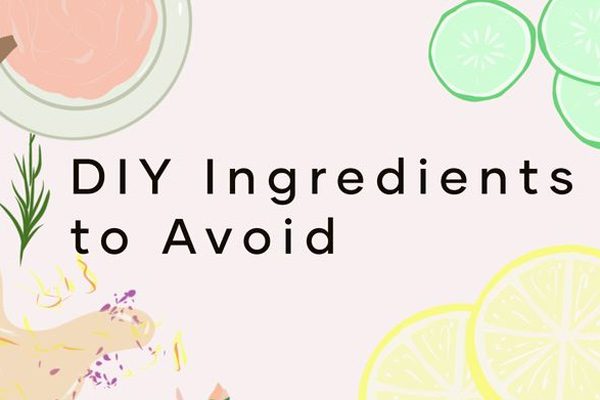DIY skincare can be fun and useful, but the ingredients you’ve been using might not be great for your skin! (Number 3 will SHOCK you!)
Did you know that skin absorbs about 66% of what you apply to it topically? That being said, while DIY skincare can be both a fun pastime as well as a favor to your wallet, it’s important that you always do deep research on the ingredients you use on your skin as well as the mixtures you create. While DIY skincare is normally comprised of natural ingredients, that doesn’t necessarily mean they are all the best for you. As a matter of fact, some of the most common DIY skincare ingredients have some harsh side-effects. Let’s talk about that — and what ingredients you can use instead that won’t be harmful to your skin!
More from Glowing Gorgeous: Find out here the Best Silicone-Free Moisturizers And Why Do You Care
-
Witch Hazel
Witch hazel is often proclaimed as a great DIY toner, and can be really good for oily skin if used properly. However, what most people don’t know is that witch hazel is usually distilled by alcohol or immersed in it as a preservative before it is bottled and sold. This can literally tear apart the skin’s hydrating layer, leaving it dry and flaky (not to mention the fact that the natural fragrance in witch hazel is eugenol, a potent irritant.) If you do choose witch hazel and it works for you, be sure you reach for a 100% witch hazel like Thayers Alcohol-Free Witch Hazel Toner.
Instead of using witch hazel the next time you craft a DIY toner, curate your own cucumber water toner instead! Cucumber is wonderfully soothing and calming for your skin and very water-rich and nourishing, making it perfect for dry or irritated skin or to help ‘calm down’ any redness. To make a toner using cucumber simply peel and chop up one medium cucumber (ideally organic and washed with some water and diluted apple cider vinegar) into small cubes. Blend the cucumber and then drain the juice liquid into a bowl through a sieve. Store in a bottle in the refrigerator for up to one week.
-
Cinnamon
While some DIY skincare recipes list cinnamon as an ingredient for exfoliation, studies show that the spice can easily cause skin irritation, blisters, and in some cases, even burns after just one use.
Instead, very finely ground organic oatmeal is perfect for gentle exfoliation! You can grind oatmeal in a blender, food processor, or mortar and pestle for perfect granular consistency.
-
Coconut Oil
Ah, coconut oil. Having been proclaimed as the DIY cure-all for as long as I can remember, it’s hard to imagine that this skincare staple belongs on this list! However, studies show that coconut oil might not be the best thing for some skin types. For some, it can be comedogenic, causing pores to become clogged and breakouts to occur as a result.
Instead of clogging your pores with coconut oil, use aloe vera for all kinds of DIY skincare! Aloe vera, as opposed to coconut oil, is incredibly hydrating and cleansing, so you can trust it for nearly every one of your DIY skincare needs.
-
Eggs
Raw eggs included in recipes for firming, anti-aging creams without a proper preservative can be incredibly scary. While using raw eggs as a single ingredient treatment is less risky than mixing them with other ingredients, you still have to worry about salmonella, listeria, staphylococcus aureus, avian influenza, and other food-borne pathogens.
Instead of using raw ingredients that could make you sick, do a facial massage to help tighten your skin! All you’ll need are your hands and a non-comedogenic oil of your choice!
Check out this article for some good massage techniques -
Toothpaste
Even though the “toothpaste to help reduce a pimple” hack has been around forever, toothpaste’s main ingredients — peroxide and baking soda — aren’t so great for your skin. And even though it can bring down inflammation temporarily, it will eventually create irritation. Even worse, you run the risk of being left with marks and discoloration after the acne has faded.
A more natural way to take care of acne comes in the form of tea tree oil. Tea tree oil is much gentler than toothpaste and is great for fighting skin inflammation.
-
Apple Cider Vinegar
Full strength raw ACV is highly irritating for the skin and can cause inflammation and burns even after just one use. As a matter of fact, it’s so acidic that it makes an effective remedy for burning off skin tags and warts, but continued use at full strength can cause permanent skin damage to surrounding tissue.
That being said, ACV itself isn’t dangerous, but you must be cautious about how you’re using it and how strong it is. As a general rule of thumb, AVC shouldn’t be used on the skin unless it is diluted to less than 20%. So feel free to continue using ACV, but consider adding 1 tbsp. to 2 cups of water instead of using it at full strength.
-
Baking Soda
Baking soda is probably better left in the kitchen. Since it has a basic pH that is much higher than where healthy skin should live, baking soda can wreak havoc on your skin’s natural lipid barriers. To avoid reactive, rashy skin, keep this orange box away from your face.
Rosehip seed powder is a much better alternative! It has health benefits for the skin and is a great gentle exfoliant.
This article was taken from Cherie, credit to user @korah



Comments